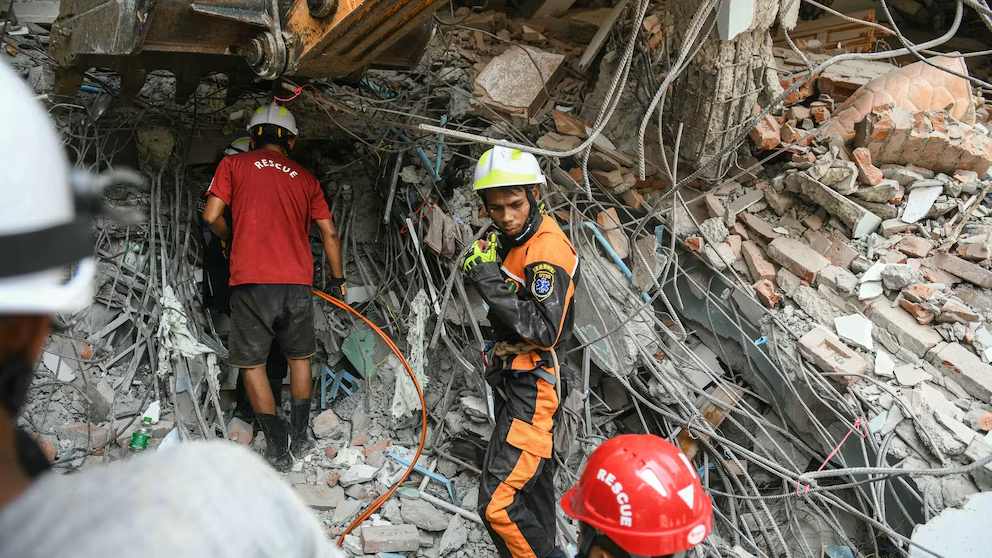The powerful 7.7-magnitude earthquake which shook Myanmar’s central region near Mandalay on March 28, 2025, has caused massive destruction, reverberating across Southeast Asia.
The tremors were felt as far as China and India, underscoring the intensity of the seismic activity.
Casualties and Structural Damage

In Myanmar, authorities have confirmed at least 1,700 fatalities, with over 3,400 people injured and more than 300 still missing.
Mandalay, one of the hardest-hit cities, has witnessed collapsed bridges, crumbling infrastructure, and widespread damage.
The historic city of Bagan, home to centuries-old temples and pagodas, has also suffered extensive ruin, with many structures either heavily damaged or reduced to rubble.
Meanwhile, in nei Thailand, the impact has also been severe, with reports confirming at least 18 deaths and 33 injuries. In Bangkok, a 30-story building under construction crumbled in the Chatuchak district, leaving several workers trapped beneath the debris.
The earthquake affected 56 out of Thailand’s 76 provinces, causing significant structural damage and panic among residents.
Ongoing Rescue and Relief Efforts

Search and rescue teams are racing against time to pull survivors from the wreckage in both Myanmar and Thailand.
Emergency response crews, alongside international aid organizations, are on the ground providing medical assistance and relief supplies. In Mandalay, teams face logistical hurdles due to damaged roads and persistent aftershocks, making access to affected areas more challenging.
Several countries, including China and India, have dispatched search and rescue teams, medical personnel, and emergency supplies to assist Myanmar.
Despite these efforts, the response in Myanmar is complicated by the country’s ongoing political turmoil.
Myanmar’s Political Landscape Complicates Aid Distribution
The relief operation in Myanmar faces additional challenges due to the nation’s internal conflict. The opposition-led National Unity Government (NUG) and the People’s Defense Force have declared a temporary ceasefire in earthquake-affected zones to allow aid to be delivered.
However, concerns persist about whether Myanmar’s military-led government will fairly distribute assistance to all communities, given its history of uneven disaster response.
Thailand’s Response and Future Prevention Measures
Thailand has swiftly mobilized emergency relief efforts, with Prime Minister Paetongtarn Shinawatra declaring Bangkok a disaster zone. Investigations have been launched to determine why certain structures, including the collapsed high-rise in Chatuchak, failed to withstand the tremors.
To mitigate future risks, Thailand is now exploring advanced earthquake-resistant technologies. One proposed measure involves implementing seismic isolation systems, which elevate buildings and allow them to absorb shock waves more effectively.
Additionally, authorities are reviewing building codes and urban planning strategies to improve structural resilience across the country.
Aftershocks and the Road to Recovery

Myanmar and Thailand, both located in seismically active zones, have experienced numerous earthquakes throughout history. Myanmar, in particular, sits along the boundary of the Indian and Eurasian tectonic plates, making it highly prone to devastating tremors. The country has recorded several major quakes, including the 1839 Ava earthquake, the 1912 Maymyo quake, and more recently, the 2012 Thabeikkyin earthquake. However, the March 28, 2025, 7.7-magnitude quake stands as one of the deadliest in Myanmar’s modern history, leaving over 1,700 dead and thousands injured.
Thailand, though less prone to powerful earthquakes, has also felt the impact of seismic activity over the years. Notable quakes include the 1975 northern region earthquake, the 1983 Kanchanaburi tremor, and the 2014 Mae Lao earthquake in Chiang Rai province. The latest disaster originating from Myanmar sent shockwaves through Thailand, causing a 30-story building collapse in Bangkok and affecting 56 out of the country’s 76 provinces.
The region continues to experience aftershocks, raising concerns about further damage to already weakened structures. Authorities are urging residents to remain in safe areas and avoid returning to unstable buildings. The full scale of the destruction is still being assessed, and as rescue efforts continue, the death toll is expected to rise.
This earthquake has been one of the most devastating in Southeast Asia in recent history, underscoring the urgent need for coordinated international support and robust disaster preparedness plans to mitigate the impact of future seismic events.
Discover more from LN247
Subscribe to get the latest posts sent to your email.


